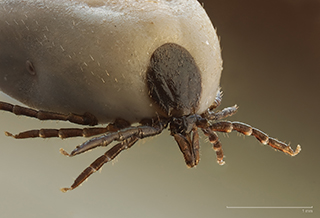Fighting Vector-Borne Illness
The School of Public Health and the Department of Atmospheric & Environmental Sciences partner on a $10 million initiative to address West Nile Virus and other diseases
ALBANY, N.Y (June 6, 2018) — The University at Albany is partnering with seven other universities and three state departments of health, including the New York State Department of Health, as part of the $10 million Northeast Center for Excellence in Vector-borne Diseases (NEVBD) at Cornell University.
 |
|
UAlbany is partnering with seven other universities and three state departments of health as part of the $10 million Northeast Center for Excellence in Vector-borne Diseases, hosted at Cornell University.
|
UAlbany’s Department of Atmospheric and Environmental Sciences (DAES) and School of Public Health (SPH) are academic partners in the NEVBD, which will address the surveillance, prevention, and response to vector borne diseases.
The NEVBD is one of only five such regional centers in the country, with Cornell University leading the team of medical entomologists, virologists, epidemiologists, ecologists, climate scientists, modelers, and molecular biologists.
A just-released CDC report concluded that disease caused by tick, mosquito and flea bites more than tripled in the US between 2004 and 2016, and that 9 new diseases were either discovered or detected here for the first time during that same period. It is widely accepted that temperatures and rainfall affect the abundance of mosquitoes, spread of pathogens, and incidence of disease; indicative of the need for the NEVBD.
With seed funding from UAlbany’s Division for Research, UAlbany’s DAES and SPH have partnered with New York State Department of Health Wadsworth Center on vector-borne illness related research by forming the Climate Change and Emerging Infectious Diseases (CCEID) working group in 2015. Together, UAlbany and NYSDOH scientists and collaborated to better understand what environmental factors increase or decrease human health risk from vector-borne pathogens in the Northeast United States and to analyze the spatial and temporal variations of West Nile virus infections. The seed funding provided the essential support for a student conduction undergraduate summer research in 2017.
Now, as part of the NEVBD project, CCEID aims to develop process-based numerical models that can be used as new predictive tools. Initially, the team is using data analytics to test how well these models can reproduce the past changes in West Nile virus prevalence in mosquitoes and associated human cases. If these models can achieve accurate prediction levels, new opportunities would be revealed to use seasonal climate forecasts and climate change scenarios to project the level of risk associated with West Nile virus and other medically important episodic vector-borne diseases such as Eastern equine encephalitis.
More information about the NEVBD including a full list of collaborators can be found here.
![]() For more news, subscribe to UAlbany's RSS headline feeds
For more news, subscribe to UAlbany's RSS headline feeds
A comprehensive public research university, the University at Albany-SUNY offers more than 120 undergraduate majors and minors and 125 master's, doctoral and graduate certificate programs. UAlbany is a leader among all New York State colleges and universities in such diverse fields as atmospheric and environmental sciences, business, education, public health,health sciences, criminal justice, emergency preparedness, engineering and applied sciences, informatics, public administration, social welfare and sociology, taught by an extensive roster of faculty experts. It also offers expanded academic and research opportunities for students through an affiliation with Albany Law School. With a curriculum enhanced by 600 study-abroad opportunities, UAlbany launches great careers.


